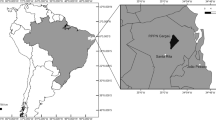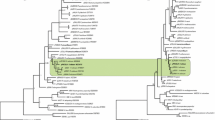Abstract
Native European passerine birds are frequently clinically inapparent carriers of haemosporidian parasites of the genus Plasmodium. Clinical disease and death are only exceptionally reported. In the present study, tissue samples of 233 wild passerine birds found dead in Eastern Austria were examined by in situ hybridization (ISH) and partial cytochrome B gene sequence analysis for the presence, abundance and taxonomic assignment of Plasmodium spp. In 34 cases (14.6 %), ISH yielded a positive result with large numbers of developmental stages in different cell types of the spleen, liver, brain and lung. The abundance of the tissue stages, which was comparable to fatal cases of avian malaria in penguins, suggested a major contribution to the cause of death. Genetic analysis revealed infections with representatives of three different valid species of Plasmodium, Plasmodium elongatum, Plasmodium lutzi and Plasmodium vaughani. Genetically identical parasite lineages had been found in a previous study in penguins kept in the Vienna zoo, providing evidence for the role of wild birds as reservoir hosts. Further, this study provides evidence that several species of Plasmodium are able to abundantly proliferate in endemic wild birds ultimately resulting in mortalities.



Similar content being viewed by others
References
Atkinson CT, Lapointe DA (2009) Introduced avian diseases, climate change and the future of Hawaiian honeycreepers. J Avian Med Surg 23:53–63
Atkinson CT, Dusek RJ, Lease JK (2001) Serological response and immunity to superinfection with avian malaria in experimentally –infected Hawaii amakihi. J Wildl Dis 37:20–27
Bensch S, Hellgren O, Pérez-Tris J (2009) MalAvi: a public database of malaria parasites and related haemosporidians in avian hosts based on mitochondrial cytochrome b lineages. Mol Ecol Resour 9:1353–1358
Bentz S, Rigaud T, Barroca M, Martin-Laurent F, Bru D, Moreau J, Faivre B (2006) Sensitive measure of prevalence and parasitaemia of haemosporidia from European blackbird (Turdus merula) populations: value of PCR-RFLP and quantitative PCR. Parasitology 133:685–692
Blanco G, Merino S, Telia JL, Fargallo JA, Gajón A (1997) Hematozoa in two populations of the threatened red-billed chough in Spain. J Wildl Dis 33:642–645
Chvala S, Bakonyi T, Bukovsky C, Meister T, Brugger K, Rubel F, Nowotny N, Weissenböck H (2007) Monitoring of Usutu virus activity and spread by using dead bird surveillance in Austria, 2003-2005. Vet Microbiol 122:237–245
Cranfield MR, Shaw M, Beall F, Skjoldager M, Ialeggio M (1990) A review and update of avian malaria in the African penguin (Spheniscus demersus). Proc Am Assoc Zoo Vet 243-248
Dinhopl N, Mostegl MM, Richter B, Nedorost N, Maderner A, Fragner K, Weissenböck H (2011) Application of in-situ hybridization for the detection and identification of avian malaria parasites in paraffin wax-embedded tissues from captive penguins. Avian Pathol 40:315–320
Figuerola J, Muñoz E, Gutiérrez R, Ferrer D (1999) Blood parasites, leucocytes and plumage brightness in the cirl bunting, Emberiza cirlus. Funct Ecol 13:594–601
Fix AS, Waterhouse C, Greiner EC, Stoskopf MK (1988) Plasmodium relictum as a cause of avian malaria in wild-caught Magellanic penguins (Spheniscus magellanicus). J Wildl Dis 24:610–619
Fleischmann RW, Sladen WJL, Melby EC (1968) Malaria (Plasmodium elongatum) in captive African penguins (Spheniscus demersus). J Am Vet Med Assoc 153:928–935
Graczyk TK, Cranfield MR, McCutchan TF, Bicknese EJ (1994) Characteristics of naturally acquired avian malaria infections in naïve juvenile African black-footed penguins (Spheniscus demersus). Parasitol Res 80:634–637
Grim CK, van der Merwe E, Sullivan M, Parson N, McCutchan TF, Cranfield M (2003) Plasmodium juxtanucleare associated with mortality in black footed penguins (Spheniscus demersus) admitted to a rehabilitation center. J Zoo Wildl Med 34:250–255
Howe L, Castro IC, Schoener ER, Hunter S, Barraclough RK, Alley MR (2012) Malaria parasites (Plasmodium spp.) infecting introduced, native and endemic New Zealand birds. Parasitol Res 110:913–923
Loupal G, Kutzer E (1995) Infektionen mit Plasmodium spec. bei Papageitauchern (Fratercula arctica). Kleintierpraxis 41:901–906 (in German)
Mantilla JS, Matta NE, Pacheco MA, Escalante AA, González AD, Moncada LI (2013) Identification of Plasmodium (Haemamoeba) lutzi (Lucena, 1939) from Turdus fuscater (Great thrush) in Colombia. J Parasitol 99:662–668
Martínez J, Martínez-de la Puente J, Herrero J, Del Cerro S, Lobato E, Rivero-de Aguilar J et al (2009) A restriction site to differentiate Plasmodium and Haemoproteus infections in birds: on the inefficiency of general primers for detection of mixed infection. Parasitology 136:713–722
Pérez-Tris J, Bensch S (2005) Diagnosing genetically diverse avian malarial infections using mixed-sequence analysis and TA-cloning. Parasitology 131:15–23
Scheuerlein A, Ricklefs RR (2004) Prevalence of blood parasites in European passeriform birds. Proc R Soc Lond B 271:1363–1370
Schoener ER, Banda M, Howe L, Castro IC, Alley MR (2014) Avian malaria in New Zealand. N Z Vet J 62:189–198
Seidel B, Silbermayr K, Kolodziejek J, Indra A, Nowotny N, Allerberger F (2013) Detection of Plasmodium sp.-infested Anopheles hyrcanus (Pallas 1771) (Diptera: Culicidae) in Austria, 2012. Wien Klin Wochenschr 125:139–143
Shurulinkov P, Golemansky V (2003) Plasmodium and Leucocytozoon (Sporozoa: Haemosporida) of wild birds in Bulgaria. Acta Protozool 42:205–214
Sturrock HJW, Tompkins DM (2007) Avian malaria (Plasmodium spp.) in yellow-eyed penguins: investigating the cause of high seroprevalence but low observed infection. N Z Vet J 55:158–160
Valkiūnas G (2005) Avian malaria parasites and other Haemosporidia. CRC Press, Boca Raton
Valkiūnas G, Zehtindjiev P, Dimitrov D, Krizanauskiene A, Iezhova TA, Bensch S (2008) Polymerase chain reaction-based identification of Plasmodium (Huffia) elongatum, with remarks on species identity of haemosporidian lineages deposited in GenBank. Parasitol Res 102:1185–1193
Votypka J, Simek J, Tryjanowski P (2003) Blood parasites, reproduction and sexual selection in the red-backed shrike (Lanius collurio). Ann Zool Fenn 40:431–439
Zehtindjiev P, Križanauskiene A, Scebba S, Dimitrov D, Valkiūnas G, Hegemann A, Tieleman BI, Bensch S (2012) Haemosporidian infections in skylarks (Alauda arvensis): a comparative PCR-based and microscopy study on the parasite diversity and prevalence in southern Italy and the Netherlands. Eur J Wildl Res 58:335–344
Acknowledgments
The authors wish to thank Karin Fragner, Gudrun Kurz and Klaus Bittermann for their excellent technical support. The present study was funded by the Austrian Science Fund (FWF) grant P20926.
Conflict of interest
The author(s) declared no potential conflicts of interest with respect to the research, authorship and/or publication of this article.
Author information
Authors and Affiliations
Corresponding author
Rights and permissions
About this article
Cite this article
Dinhopl, N., Nedorost, N., Mostegl, M.M. et al. In situ hybridization and sequence analysis reveal an association of Plasmodium spp. with mortalities in wild passerine birds in Austria. Parasitol Res 114, 1455–1462 (2015). https://doi.org/10.1007/s00436-015-4328-z
Received:
Accepted:
Published:
Issue Date:
DOI: https://doi.org/10.1007/s00436-015-4328-z




